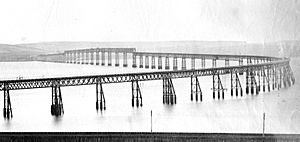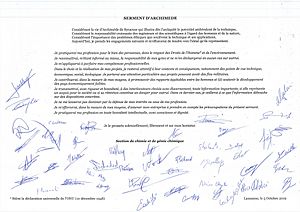Engineering ethics facts for kids
Engineering ethics is all about the rules and principles that guide engineers in their work. It's like a moral compass that helps engineers make good decisions. These rules make sure engineers are responsible to the public, their clients, and their own profession. It's a bit like thinking about what's right and wrong when you're building something or designing a new technology.
Contents
How Engineering Ethics Started
Early Days of Engineering
In the 1800s, engineering became a real profession. Engineers started working on big projects like bridges and machines. At first, people thought ethics was a personal thing, not something for the whole engineering field.
But as engineering grew, some big problems happened.
Big Disasters and New Rules
As the 19th century ended and the 20th century began, there were several terrible accidents involving engineering projects. Some famous bridge collapses, like the Tay Bridge disaster in 1879 and the Quebec Bridge collapse in 1907, showed everyone that engineers needed clearer rules. These disasters caused many deaths and made engineers realize they had to improve their safety standards and ethical guidelines.

Because of these accidents, major engineering groups started creating official codes of ethics. For example, the American Institute of Electrical Engineers made their code in 1912. The American Society of Civil Engineers and the American Society of Mechanical Engineers followed in 1914.
These events, along with the Boston molasses disaster in 1919, also led to the idea that engineers should be officially licensed. This means engineers have to meet certain education, experience, and testing requirements to prove they are qualified and safe to practice.
Later, in 1950, German engineers created an oath called 'The Confession of the Engineers'. This showed how important it was for engineers to think about their role in society, especially after World War II.
Today, most places require engineers to be licensed if their work could affect public safety, health, or the environment. This helps make sure that engineers are always working to protect people.
Modern Efforts in Engineering Ethics
Engineers continue to work on making sure everyone follows ethical practices. Groups like the Canadian Iron Ring and the American Order of the Engineer were created after the 1907 Quebec Bridge collapse. Members of these groups take an oath to act ethically and wear a special ring to remind them of their promise.
In the United States, the National Society of Professional Engineers created a Code of Ethics in 1964. They also set up a Board of Ethical Review in 1954. This board helps engineers understand how to handle tricky ethical problems they might face every day.
New challenges keep coming up, like how to deal with projects done in other countries (offshoring), making sure development is sustainable, and protecting the environment. Engineers are always thinking about these new ethical questions.
Main Rules for Engineers
Engineers, in the fulfillment of their professional duties, shall hold paramount the safety, health, and welfare of the public
A practitioner shall regard the practitioner's duty to public welfare as paramount."
Engineering codes of ethics usually put the public's safety and well-being first. This means engineers must always think about how their work affects people and the environment.
Many engineering groups around the world have their own codes of ethics. These codes are very similar, showing that engineers everywhere agree on the most important principles. Even with these rules, engineers still need good judgment to decide how to apply them in different situations.
Here are some common principles from the American Society of Civil Engineers:
- Engineers must always put the safety, health, and well-being of the public first. They should also try to make projects sustainable.
- Engineers should only work on projects they are good at and qualified for.
- Engineers must be honest and fair when they speak publicly about their work.
- Engineers should act loyally for their clients and employers. They must avoid situations where their personal interests could conflict with their work.
- Engineers should build their reputation based on the quality of their work, not by being unfair to others.
- Engineers must act in a way that honors the engineering profession. They should not tolerate bribery, fraud, or corruption.
- Engineers should keep learning throughout their careers and help other engineers grow professionally.
- Engineers must treat everyone fairly, no matter their gender, race, age, or other differences.
In 1990, students at EPFL (a university in Switzerland) created the Archimedean Oath. This is like the Hippocratic Oath for doctors, but for engineers. It's a promise to practice engineering ethically.
Responsibility to Society
The most important rule for engineers is to protect the safety and well-being of the public. This is a core value for almost all engineering organizations.
Here are some examples of what different engineering groups say about this:
- Institute of Electrical and Electronics Engineers: Engineers must take responsibility for decisions that affect public safety and health. They should quickly share any information that might put the public or environment at risk.
- Institution of Civil Engineers: Members must always remember their main responsibility is to the public good. This includes caring for the environment and historical sites, as well as protecting the health of people now and in the future.
- Professional Engineers Ontario: An engineer's duty to public welfare is the most important thing.
- National Society of Professional Engineers: Engineers must put the safety, health, and well-being of the public first.
- American Society of Mechanical Engineers: Engineers must prioritize the safety, health, and well-being of the public in their work.
- American Institute of Chemical Engineers: Members must put the safety, health, and well-being of the public first and protect the environment.
Engineers know that their work has a big impact on society. They must use their skills to help humanity and make the world a better place. They should refuse any project that could harm the public interest, the environment, or people's health and rights.
It's an engineer's duty to keep the profession respected by being skilled, honest, strong, modest, and fair. They should always put the good of society before their own personal gain. Engineers should also keep learning and share their knowledge to help others grow in the profession. They must work efficiently and follow all laws, especially those that protect workers.
Speaking Up (Whistleblowing)

Sometimes, an engineer might see a problem that could be dangerous to others, like a client or employer not following safety rules. A basic ethical rule is that the engineer has a duty to report this risk to the right authorities. This duty is more important than their duty to a client or employer. If an engineer doesn't report a danger, they could lose their license, even if no one gets hurt.
If a non-technical person or another authority tells an engineer to do something different from their advice, the engineer must explain in writing why their advice is important and what could happen if it's not followed.
Most of the time, engineers can solve these issues by clearly explaining the risks to their client. But in very rare cases, if even the government doesn't act, an engineer might have to make the situation public. This is called whistleblowing. Courts have often supported engineers who blow the whistle, saying that protecting the public is more important than keeping secrets for an employer.
Professional Behavior
Engineers face many other ethical questions in their work. These often involve how they act in business. Some examples include:
- How engineers interact with clients, other experts, competitors, and contractors.
- Making sure clients and their contractors follow all laws.
- Avoiding conflicts of interest, where personal gain might affect professional decisions.
- Refusing bribes or illegal payments, which can include gifts, meals, or entertainment that are too much.
- Keeping sensitive or secret information private.
- Being careful with their employer's resources.
- Not working for other companies (moonlighting) if it conflicts with their main job.
Some engineering groups are also focusing on environmental protection as a key ethical issue. The field of business ethics also helps engineers make good decisions.
Real-Life Examples and Important People
Many engineering failures are not just simple mistakes; they often involve problems with the design process or how a company is managed. However, not all failures are ethical issues. For example, the collapse of the first Tacoma Narrows Bridge was a technical and design problem, not an ethical one. But some engineering successes can also be ethical failures, like when engineers' work is used for harmful purposes.
Here are some famous cases where engineering failures involved both technical and ethical issues:
- General Motors ignition switch recalls (2014) – Problems with car parts.
- Deepwater Horizon oil spill (2010) – A huge oil spill in the ocean.
- Space Shuttle Columbia disaster (2003) and Space Shuttle Challenger disaster (1986) – Tragic space shuttle accidents.
- Therac-25 accidents (1985 to 1987) – Malfunctions in a radiation therapy machine.
- Chernobyl disaster (1986) – A major nuclear power plant accident.
- Bhopal disaster (1984) – A deadly gas leak in India.
- Kansas City Hyatt Regency walkway collapse (1981) – A hotel walkway collapsed.
- Love Canal (1980) – A neighborhood built on a toxic waste dump, with Lois Gibbs helping to bring attention to it.
- Three Mile Island accident (1979) – A serious nuclear power plant incident.
- Citigroup Center (1978) – A building with a design flaw that was fixed ethically.
- Ford Pinto safety problems (1970s) – Car design issues that made it unsafe.
- Minamata disease (1908–1973) – A severe illness caused by mercury pollution.
- Aberfan disaster (1966) – A coal waste tip collapsed onto a school.
- Chevrolet Corvair safety problems (1960s) – Car safety issues highlighted by Ralph Nader in his book Unsafe at Any Speed.
- Boston molasses disaster (1919) – A huge tank of molasses burst.
- Quebec Bridge collapse (1907) – A bridge collapsed during construction, with Theodore Cooper involved.
- Johnstown Flood (1889) – A dam break caused a massive flood.
- Tay Bridge Disaster (1879) – A railway bridge collapsed in a storm, with Thomas Bouch as the engineer.
- Ashtabula River Railroad Disaster (1876) – A railroad bridge collapsed.
See also
In Spanish: Ética de la ingenier%C3%ADa para ni%C3%B1os




